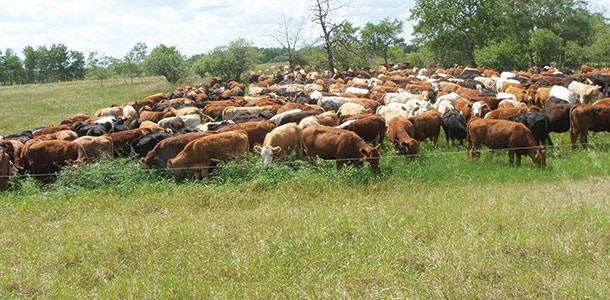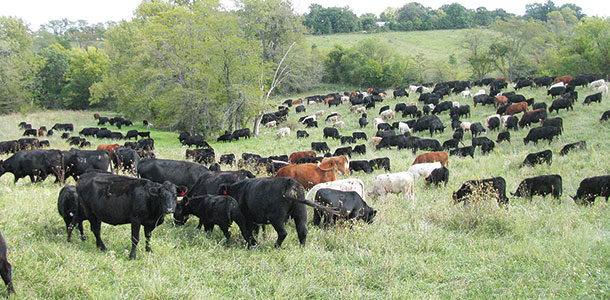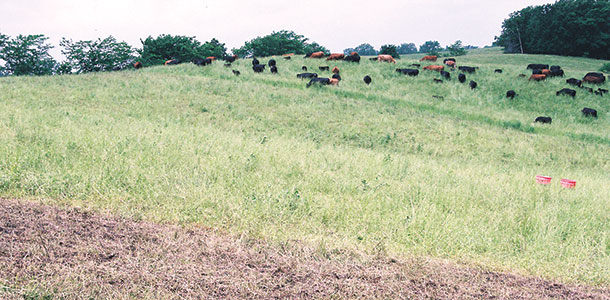There were meetings all winter long with speakers from North Dakota, Ohio and Kansas – talking about crazy mixtures of cover crops and even planting cover crops into their standing corn or beans.
So what cool ideas have they been teaching about soil health in cropland and how can we incorporate those ideas into pasture/range management? First, there are four basic tenets of soil health, and I think they are very applicable to pasture/rangeland. They are:
- You need a living root in the soil to provide a food source for the organisms in the soil.
- You need to keep the soil completely covered with mulch and living plants 365 days a year.
- You need to disturb the soil as little as possible.
- You need to have plant diversity.
Incorporating these four things into your pasture/range management may not be as hard as you think.

Living roots feed soil livestock
One of the primary food sources for organisms in the soil is the sugary exudates the plants give off. The plants are in control. The plants actually determine the amount of organisms by how much exudate they give off.
Some plants actually give up 60 percent of their photosynthetic energy in the form of exudates to attract soil organisms, which in turn bring them nutrients and minerals the plant otherwise couldn’t get. In a cropping system with summer-annual crops like corn or soybeans, planting a cover crop during the off-season is critical to providing a living root food source for the soil organisms. In a perennial pasture, we should have living roots there all year long.
However, we do need to make sure we keep that feed trough for those soil organisms as big as possible. How do we do that? Most of us have always been taught the root systems of a plant are a reflection of the above-ground biomass.
To keep the root system big, and the biological feed trough full, we need to manage for actively growing taller plants that have had adequate recovery periods during the growing season.
We all plan on how much pasture and hay we need for our cattle for the year or winter. The bottom line is: Do you put thought and specific action into feeding and managing your soil livestock?

Keep the soil covered
Soil organisms are like you and I; they do their best work at around 70ºF. Most are considered subaquatic, meaning they live and swim around in the very thin film of water on the face of the soil particles and around the plant roots.
Earthworms can move to wetter areas in the soil, but most other organisms can’t move rapidly through soil. If the soil quickly gets hot and dries out, they either go dormant or die. In either case, they won’t be breaking down organic matter and making minerals available to our forage plants.
I have measured more than 30ºF differences in side-by-side fields in the summer. Keeping a taller canopy as much of the summer as possible is critical to help keep the soil cooler and more biologically active. A mulch layer on the soil surface helps keep the soil cool and reduces moisture loss as well as providing a food source for the soil organisms.
How do you keep a mulch layer on the soil? Hayfields will seldom have any kind of a mulch layer. Continuously grazed fields will seldom ever have a mulch layer either. Grazing and trampling down fairly mature lignified material is about the only consistent way of achieving a good mulch layer.

Less disturbance
To understand how “less disturbance” helps soil health, we need to understand what “succession” is. When you abandon a cropfield, the first thing that grows are annual weeds like ragweed. In years that follow, we will get more annuals, some biennials, some perennial grasses and then in areas with enough rainfall, woody plants.
Succession is the process of the land covering and healing itself with a wide variety of plants that accomplish many different things. In the end, that healing process produces a soil that has a good balance of all types of soil organisms. Normally, soils with the least amount of disturbance have the highest level of biological activity.
We typically think of soil disturbance as tillage. Disking, plowing and cultivating are what comes to mind for most of us. Disturbance to the soil ecosystem can also come in other forms.
Chemicals, fertilizer, fire, haying and yes, even grazing, are forms of disturbance to the soil ecosystem. Chemicals and fertilizer can both be used beneficially, but both can also upset the nutrient cycle, which in turn can upset the balance of organisms in the soil. When applying either, we need to understand how they impact the soil organisms.
Very likely the biggest disturbance in most grassland is haying. In just one operation, you remove the protective canopy and food source for the soil organisms. I really don’t have room here to discuss all the damaging effects to the soil of haying, and since there is not really much of a way to lessen the effects of haying, we need to focus on reducing the amount of hay needed through your grazing management.
Grazing is also a disturbance that can set succession back. From a soil health standpoint, we want succession to be advanced as far as possible without letting it get to the woodland state or to a condition where we cannot harvest forage with livestock. Lengthening the rest periods typically reduces the grazing disturbance and allows for a healthier soil.
Diversity
There are no natural ecosystems I know of that are monocultures. When we think of the most productive land with the best soils, we usually think of the Midwest. Those were soils that developed under very diverse mixtures with, in some cases, hundreds of different types of plants.
These prairie plants can be lumped into basically four forage types: cool-season grass, warm-season grass, cool-season broadleaves and warm-season broadleaves.
Some of these plants will have deep taproots, some shallow fibrous roots, some that thrive in wet years, and some will like dry growing conditions. You will have plants that provide a higher protein source for your livestock and some that provide a better energy source for them. You might have plants that do not get eaten at all by your livestock. But does that mean they don’t have a role in your field?
What if that ugly plant you call a “weed” has an incredibly deep taproot that pulls a particular mineral from way down in the soil profile that your higher-volume forages but shorter-rooted plants, like the grasses, need? They may not produce 1 pound of forage your livestock eat, but they may be the most important plant in the field.
With these diverse mixtures of plants come stability and resiliency. You will have a pasture/range field that produces something year after year regardless of the growing conditions.
Soil health may be all the rage now in row-crop circles, but it is also one of the most important considerations in pasture/range management as well. Let’s spend some time this year thinking about these four things and what we can change about our current pasture and range management that will improve our land’s soil health, productivity, and hopefully, our bottom line. ![]()
PHOTOS
PHOTO 1: This Missouri pasture displays a very diverse forage species mix. Most folks would identify this as a weedy pasture, but there are almost no leaves left in the post-grazing residual material – only plant stems. Stock density was high enough that the livestock have learned to eat almost all plants. The lignified material the cattle won’t eat is also what makes the best material to trample down as thatch and help cover the soil, enhancing the soil ecosystem. Photo courtesy of NRCS.
PHOTO 2: The stock density for these yearlings is about 1,000,000 pounds, which not only cleans up the “weeds” but effectively tramples stems, increasing effective soil cover. Photo by Terry Gompert.
PHOTO 3: The stock density in this pasture is about 150,000 pounds. Photo by Doug Peterson.
PHOTO 4: The stock density in this strip-grazing operation is about 80,000 pounds, showing adequate soil cover in the post-grazing strips. Photo by Doug Peterson.

Doug Peterson
Missouri NRCS State Soil Health Conservationist






